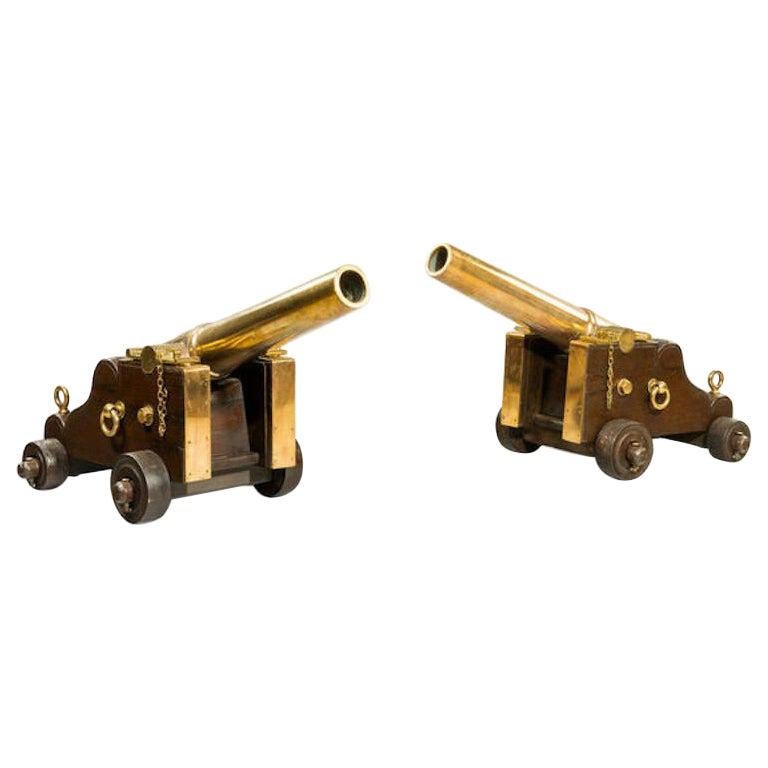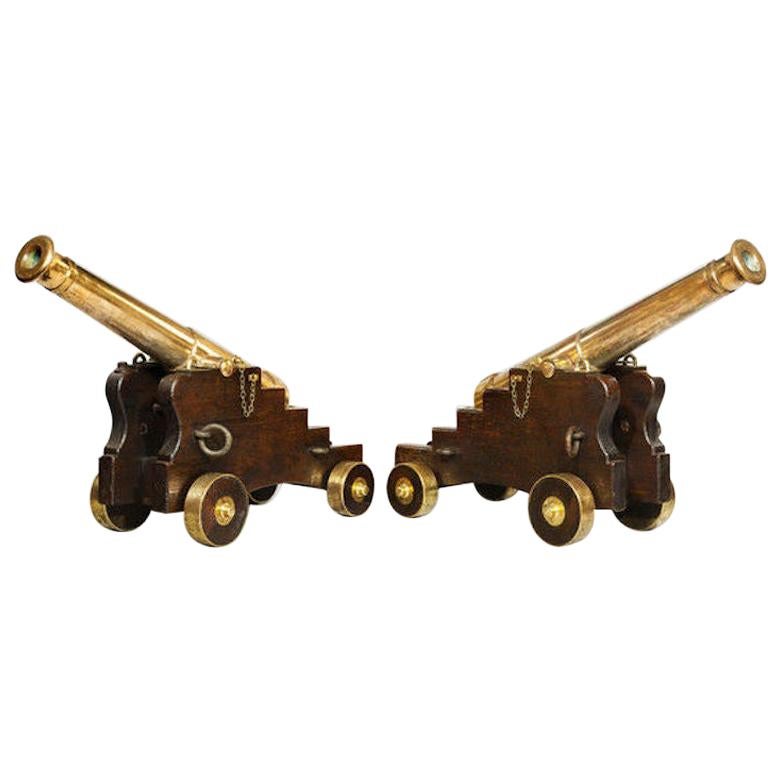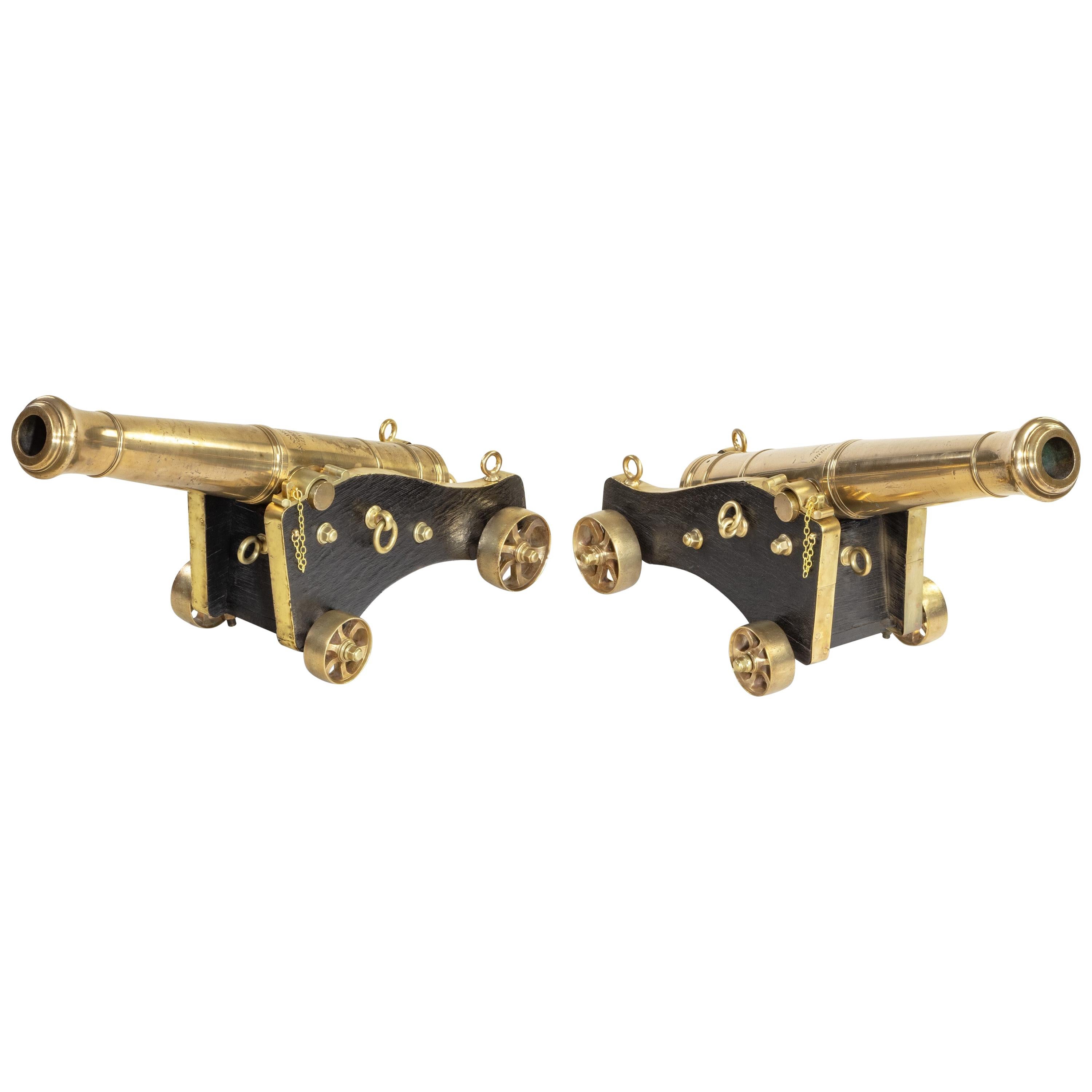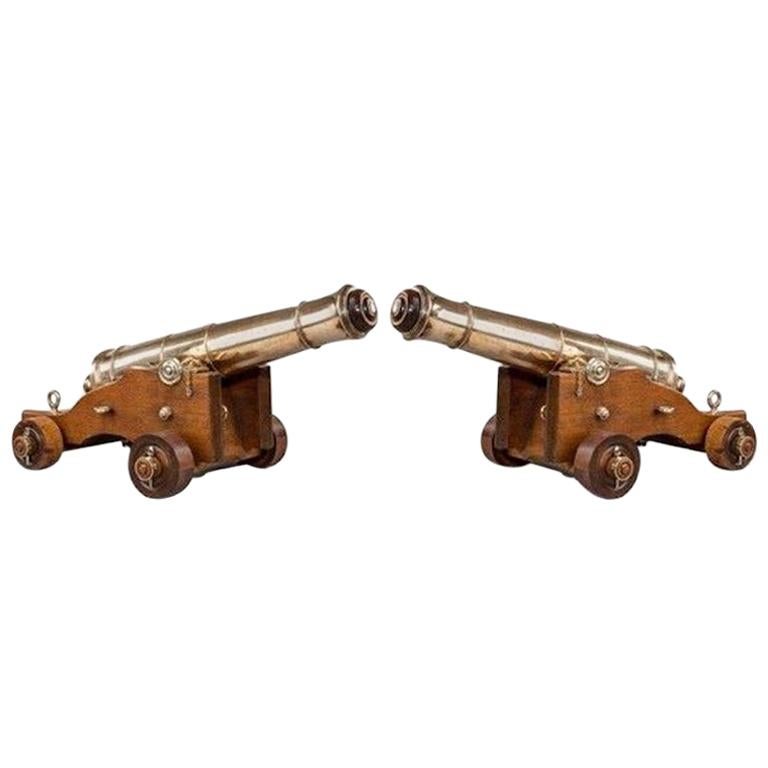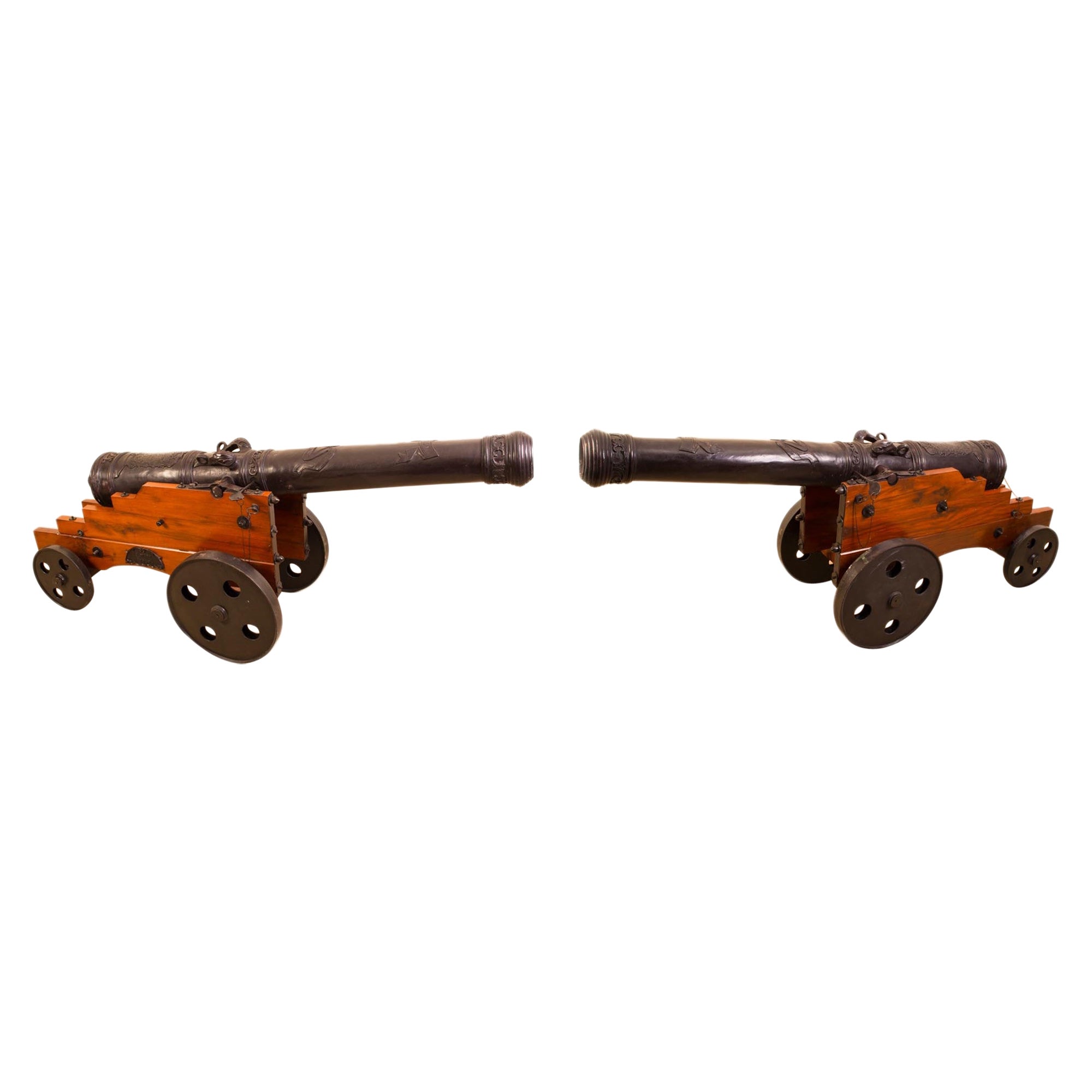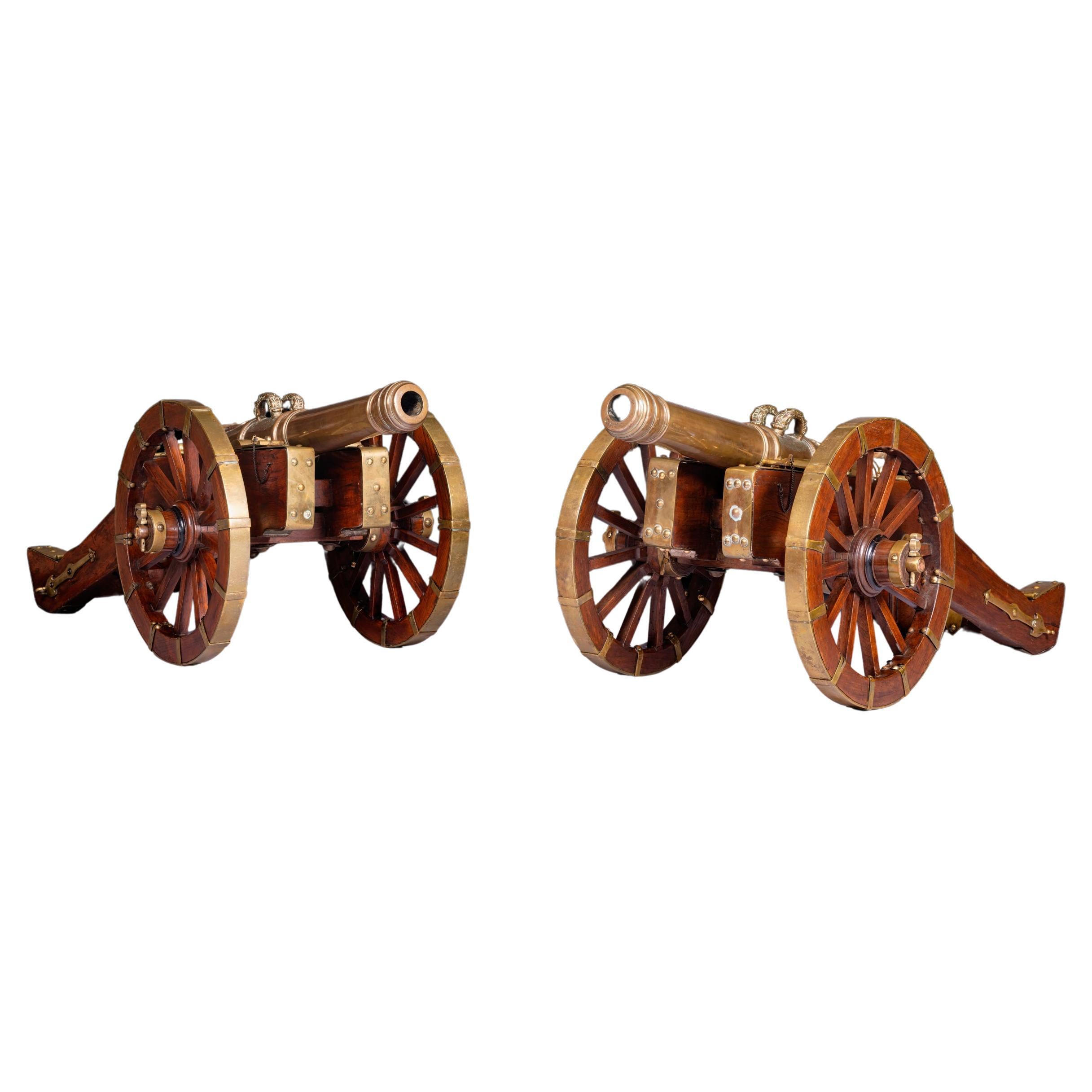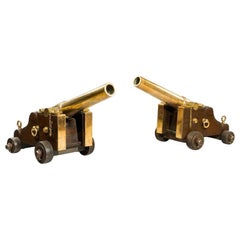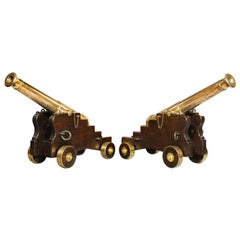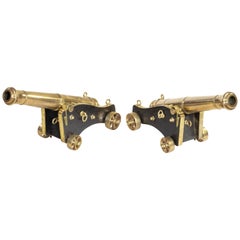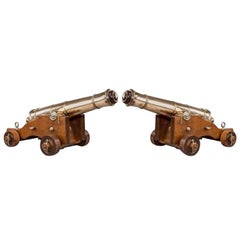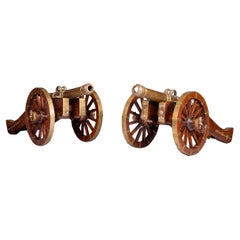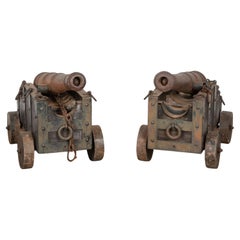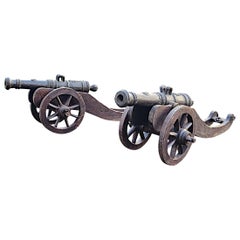Items Similar to A pair of ships’ Bronze Cannon from the S. V. Jura 1875
Want more images or videos?
Request additional images or videos from the seller
1 of 13
A pair of ships’ Bronze Cannon from the S. V. Jura 1875
$66,596.67per set
£48,750per set
€57,240.17per set
CA$93,567.05per set
A$102,374.86per set
CHF 52,825.14per set
MX$1,225,927.94per set
NOK 670,640.15per set
SEK 628,325.16per set
DKK 427,465.35per set
About the Item
A pair of ships’ Bronze Cannon from the S. V. Jura, 1875, Built by Charles Connell & Co, Glasgow, for Sandbach, Tinne & Co. of Liverpool. These fine four pounder cannon, on their original teak carriages, were made for use on the Jura, a fine Clyde-built vessel that was assembled in the Charles Connell and Company yard, no. 96, Scotstoun.
Footnote:
‘SCOTSTOUN.-Messrs Charles Connell & Company launched on Saturday a handsome iron sailing ship of 1440 tons B. M., built to the highest class in Lloyds and the Liverpool registry. She has been built to the order of Messrs Sandbach, Tinne & Company, Liverpool, for the East India trade, and is fitted with every modern improvement. As she left the ways she was named “Jura” by the wife of Captain Russell, who is to command the vessel’.
The Caledonian Maritime Research Trust site Clyde Ships has a page on the vessel with even more technical information and an image which can be seen here
To summarise, the vessel was 230ft long, 37ft wide and 21ft deep. According to the Trust, the Jura was sold to Alfred T. Parker in 1882 but we have found newspaper reports from as late as 1899 mentioning the vessel still sailing for Sandbach, Tinne and Co when docking at the Brunswick overhead dock in March of that year (see Liverpool Journal of Commerce,10th of March 1899) so there may have been a change of registered owner but not of the company for which she sailed.
As late as 1925, Captain Russell, the ship’s captain in its early days, was being fondly remembered. A letter published in the Liverpool Journal of Commerce, 12th of September 1925, reads as follows:
‘Sir,- Captain J. A. Thinne, M.P. For Wavertree, indulged in many pleasant reminiscences in his little chat to seafarers at the Gordon Smith Institute, Liverpool, the other evening. He alluded, amongst other things, to the intimate relationship which prevailed between owners and masters in his younger days, and cited an incident which took place on his firm’s sailing ship the Jura, when the late Captain Richard Russell was in command.
I well remember Captain Russell. He was a sterling seaman and a strict disciplinarian, the friend and confidant of his owners, thus very well typifying the relationship which existed between owners and masters in those days.
He died some years ago, and even to this day his memory is cherished by the writer’.
Caledonian Maritime Research Trust
Jura herself is remembered in a fascinating article in the Welsh Gazette, 1st of April 1948, which states:
‘Major Heckstall Smith, editor of the “Yachting World” has pointed out that the full-rigged ship Jura, 1,1988 tones, on her maiden voyage from Greenock to Culcutta (sic), when running her casting down, logged 420 miles from noon to noon in the year 1875. She was owned by Sandbach, Tinne and Co. of Liverpool, and sailed by Capt. Russell. It is wonderful to realise that this vessel on the day’s work would have beaten the fastest yacht by 50 or 60 miles’.
Jura was sold to Italian owners Raffaele Ferraro of Naples in 1901 and foundered off of Peru whilst transporting scrap iron to Genoa in 1908, ending the career of this remarkable vessel.
Height on carriages: 16 inches
13 inches Width
36 inch barrels
- Dimensions:Height: 16 in (40.64 cm)Width: 13 in (33.02 cm)Depth: 10 in (25.4 cm)
- Sold As:Set of 2
- Materials and Techniques:
- Place of Origin:
- Period:
- Date of Manufacture:1875
- Condition:Wear consistent with age and use. Good.
- Seller Location:Lymington, GB
- Reference Number:1stDibs: LU973046890952
About the Seller
5.0
Recognized Seller
These prestigious sellers are industry leaders and represent the highest echelon for item quality and design.
Established in 1982
1stDibs seller since 2013
137 sales on 1stDibs
Typical response time: 1 hour
Associations
LAPADA - The Association of Arts & Antiques Dealers
- ShippingRetrieving quote...Shipping from: Lymington, United Kingdom
- Return Policy
Authenticity Guarantee
In the unlikely event there’s an issue with an item’s authenticity, contact us within 1 year for a full refund. DetailsMoney-Back Guarantee
If your item is not as described, is damaged in transit, or does not arrive, contact us within 7 days for a full refund. Details24-Hour Cancellation
You have a 24-hour grace period in which to reconsider your purchase, with no questions asked.Vetted Professional Sellers
Our world-class sellers must adhere to strict standards for service and quality, maintaining the integrity of our listings.Price-Match Guarantee
If you find that a seller listed the same item for a lower price elsewhere, we’ll match it.Trusted Global Delivery
Our best-in-class carrier network provides specialized shipping options worldwide, including custom delivery.More From This Seller
View AllPair of English Bronze Signal Cannon
Located in Lymington, Hampshire
A fine pair of English bronze signal cannon, the tapering 36 inch two stage barrels set upon original mahogany carriages with bronze fittings and ...
Category
Antique 1850s English Arms, Armor and Weapons
Materials
Bronze
$72,744 / set
Fine Pair of 19th Century English Barrel Bronze Cannon on Oak Carriages
Located in Lymington, Hampshire
Fine pair of mid-19th century English bronze cannon with tapering 41" barrels and flared muzzles, the top of each breech engraved with the family crest o...
Category
Antique 1850s English Arms, Armor and Weapons
Materials
Bronze
Fine Pair of Bronze Cannon by McAndrew and Woore English, circa 1850
Located in Lymington, Hampshire
A fine pair of bronze cannon by McAndrew and Woore, set on their original brass bound black painted oak carriages with brass spider wheels, also with a p...
Category
Antique 1850s English Arms, Armor and Weapons
Materials
Bronze
Pair of Antique English Naval Cannon
Located in Lymington, Hampshire
Pair of antique English naval cannon each with a tapering three stage barrel flanked by plain trunnions, with a knob shaped cascabel button before a shaped rectangular raised vent and ending in a 3 1/2” bore muzzle, enclosing a removable conforming wood plug, circa 1800.
Stood upon a naval type bronze-mounted four wheeled wooden carriage, including its wedge shaped quoin with knob handle.
The Earls of Lonsdale, Lowther Castle, Cumbria, presumably by descent to Hugh Cecil Lowther, 5th Earl of Lonsdale (1857-1944), until sold by his heir and brother, Lancelot, 6th Earl, as part of the contents of Lowther Castle, Maple & Co. Ltd./Thomas Wyatt, Tuesday 14 April 1947 and two following days, lot 558: ‘A pair of Old Gun Metal Cannons on teakwood carriages, 3ft. 6in. long’.
Mrs. P.M. Adie-Shepherd, sold Christie’s, London, 29 May 1970, lot 96.
Lowther Castle is a castellated mansion built by Robert Smirke between 1806 and 1814 for William Lowther, 1st Earl of Lonsdale (1757-1844). It was constructed on the foundations of the former 17th century family seat, Lowther Hall, but it was only in the early 19th century that it was afforded the name ‘castle’ in keeping with the Europe-wide fashion for romanticism and which was promoted by influential characters such as William Beckford at Fonthill Abbey, Wiltshire in England and by the writer Sir Walter Scott at Abbotsford, Roxburghshire, Scotland. While it’s not known when these naval cannon were acquired for Lowther they would have been entirely fitting in the castle or its approaches and it’s likely that they were in place soon after the castle was completed, or perhaps acquired later by the 5th Earl. A tantalising possibility is that the cannon were originally aboard the East Indiaman Lowther Castle which was active in the early 19th century.
HUGH CECIL LONSDALE, 5TH EARL OF LONSDALE (1857-1944) AND THE DEMISE OF LOWTHER CASTLE
In 1882 at the age of 25 Hugh Lonsdale (1857-1944) unexpectedly inherited the earldom and with it the extensive Lonsdale estate, including tens of thousands of acres of Cumberland and Westmorland and coalfields at Whitehaven. However, despite his spectacular inherited wealth – he was suddenly one of the wealthiest men in England, over the course of his lifetime he managed to decimate the family fortune. He led a full and colourful life, one of adventure and luxury. An early intrepid escapade took place in July 1888 when, as part of an expedition called the Scotch Naturalist Society, he set embarked on horse sleigh...
Category
Antique Early 1800s English Arms, Armor and Weapons
Materials
Bronze
$180,323 / set
Late 18th Century Bronze Lantaka Cannon
Located in Lymington, Hampshire
A late 18th century bronze Lantaka cannon, the slightly tapering barrel cast with flanges and set on a hinged pin. With a modern black S-scroll Stand. D...
Category
Antique 1790s Dutch Arms, Armor and Weapons
Materials
Bronze
Royal Southampton Yacht Club Cannon
Located in Lymington, Hampshire
This pair of early Victorian three-stage bronze signal cannon are set on elm carriages with bronze fittings.
Each 39 inch tapering barrel has one reduction and a ball cascabel. Th...
Category
Antique 1840s English Historical Memorabilia
Materials
Bronze
You May Also Like
Vintage Pair Decorative 6ft Bronze Artillery Cannons 20th Century
Located in London, GB
This is an interesting vintage pair of French bronze cannons dating from the late 20th century.
The cannons have highly decorative barrels and splendid openwork carriages.
They ar...
Category
Late 20th Century Desk Sets
Materials
Bronze
Pair Of Large 19th Century English Bronze Artillery Signal Cannons
Located in Dublin, IE
A magnificent pair of 19th century British Artillery signal cannons, each with tapered bronze barrel segmented by hoops, cannon muzzle and stepped breechblock with drop-shaped cascab...
Category
Antique 19th Century English Arms, Armor and Weapons
Materials
Brass, Bronze
Pair of 19th Century Country House Naval Canons
Located in Folkestone, GB
A magnificent pair of full size replica 19th Century naval canons.
These full size '3-pound' ship' canons are replicas of the 17th and 18th Century guns that would have lined the s...
Category
Antique Late 19th Century Portuguese Country Nautical Objects
Materials
Iron
$7,923 / set
A Very Rare Pair of 19th Century Bronze Barrelled Signal Cannons on Timber Base
Located in Dublin, IE
A very rare pair of 19th Century finely cast bronze barrelled signal cannons of exceptional quality with gorgeous detail and rich patination. This fabulous pair of cannons have tape...
Category
Antique 19th Century Dutch Arms, Armor and Weapons
Materials
Bronze
Pair Giant French Bronze Cannons, Military Artillery
Located in Potters Bar, GB
Impressive pair of large French bronze cannons
Great for a garden or business
Of course being bronze these can live outside with no fear of rusting
Viewings available by appointm...
Category
Vintage 1980s Arms, Armor and Weapons
Materials
Bronze
Antique 18th century style pair of desk cannon English circa 1920
Located in Central England, GB
This superb pair of model desk cannons has been beautifully handmade in mahogany with nailed brass fittings and heavy cast bronze barrels. The attention to...
Category
Early 20th Century British Louis Philippe Models and Miniatures
Materials
Brass, Bronze
